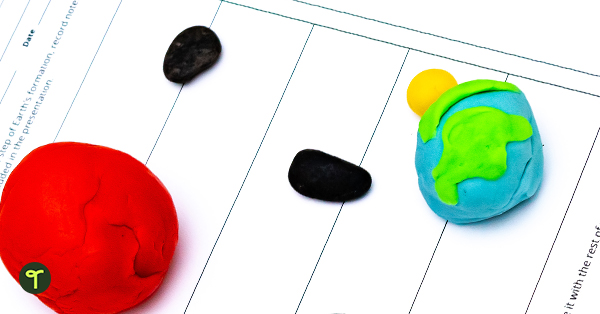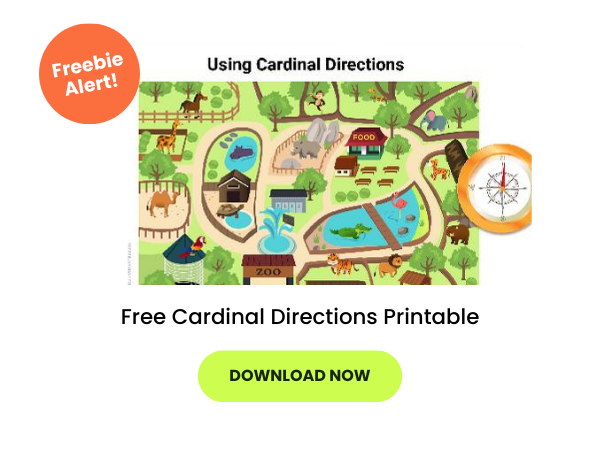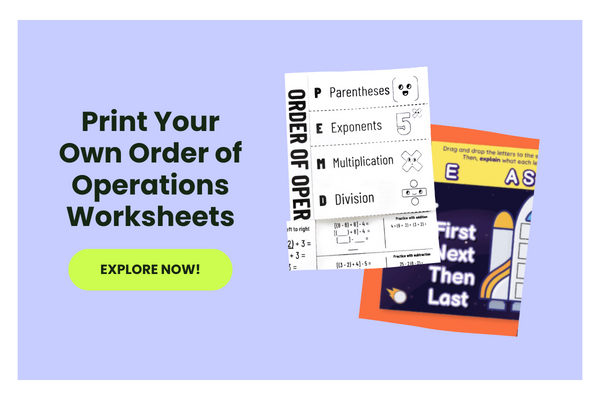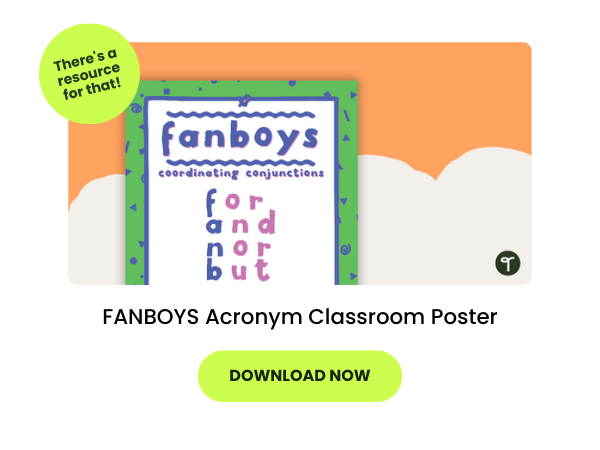How many mnemonic devices are bouncing around in your head right now? Maybe you can still remember at least a few of these educational memory aids that you learned way back when you were in elementary or middle school? From remembering the order of the planets to the names of the great lakes, there are countless songs, phrases and acronyms teachers use every day to help their students pack information in their brains to retrieve at a later date.
Which mnemonics should you use with your own students to help them recall information?
The teachers on the Teach Starter team have compiled a comprehensive list of some of the most useful mnemonic device examples they have used in their years in the classroom.
COPS? FANBOYS? PEMDAS? HOMES? We’ve got those, and a whole lot more. Some of these memory tricks date all the way back to the days when they were learning math, ELA and science as kids themselves … and they’re still just as useful today!
Explore the list of acronyms and acrostics for your science class, rhymes for ELA and more!
What Are Mnemonic Devices?
You almost certainly know your fair share of mnemonic devices, but maybe you haven’t heard the term thrown around much. It’s worth a quick visit to the dictionary for this one — a mnemonic device is essentially a memory aid that can help people remember information that might otherwise be difficult to remember. Introducing these devices during a lesson can help students learn new concepts and aid in the recall of key information later on.
Mnemonics themselves can come in a variety of forms. Among the most popular are:
- Acronyms: Using the first letter of each word in a list to form a new word can make information easier to remember. For example, “ROY G. BIV” is an acronym we often use to remember the order of colors in a rainbow (red, orange, yellow, green, blue, indigo, violet).
- Acrostics: These are similar to acronyms, but instead of forming a new word, the first letter of each word in a list is used to form a phrase or sentence that is easier to remember. For example, “Every Good Boy Does Fine” is a common acrostic used to remember the notes on the lines of a treble clef in music (E, G, B, D, F).
- Rhymes: Whether they’re set to a song or just a simple rhyming phrase, the cadence of a rhyme is a helpful memory trigger for students. For example, “i before e, except after c” is a rhyme used to remember the spelling rule for the words containing the letter combination “ie” or “ei.” Rhymes and songs are particularly helpful when it comes to reinforcing concepts throughout the school year.
- Chunking: Breaking up information into smaller, more manageable chunks is a classic mnemonic device. For example, it’s typically easier to remember a phone number as three groups of numbers rather than a string of 10 digits.
Mnemonic Device Examples for Elementary School & Middle School
Ready for the main event? Here are some mnemonic device examples that are a must-learn for elementary and middle school teachers so you can share them with your students. We’ve covered a range of topics, from the colors of the rainbow to the elements of the periodic table, so there really is something for every teacher and student in this list.
Mnemonics for the Planets in Order
Knowing all eight planets in order of distance from the sun is part of the science standards in most states, and these acrostic-style sentences will come in handy when students need to remember the entire planet list:
- My Very Educated Mother Just Served Us Noodles.
- My Very Excellent Mother Just Served Us Noodles.
- My Very Easy Method Just Speeds Up Nothing.
- My Very Easy Method Just Speeds Up Naming.
- Mother Visits Every Monday, Just Stays Until Noon.
- My Very Eager Mother Just Sent Us Nuts.
- My Very Earnest Mother Just Sent Us Nuts.
- My Very Easy Method: Just Set Up Nine.
These match up with the order of the first letters of the planets, M V E M J S U N, or:
- Mercury
- Venus
- Earth
- Mars
- Jupiter
- Saturn
- Uranus
- Neptune

An Easy Mnemonic for Dividing Fractions
Looking for a quick and easy acronym to share with students who are learning to divide fractions? It doesn’t get much easier than the three-letter acronym KCF (no, not KFC!).
KCF stands for:
- Keep the first fraction
- Change the sign from divide to multiply
- Flip the last fraction
And voila, you have a simple way to divide fractions!
How to Remember How to Spell Because
Some words are tougher to spell than others. If you have a student who always seems to misspell because, try teaching them this spelling mnemonic:
- Big Elephants Can Always Understand Small Elephants
Mnemonic for the Colors of the Rainbow
We already mentioned Roy G. Biv is an easy way to remember the order of colors in the rainbow, but here’s another fun memory trick that can help your students recall which color starts off the series:
- Richard of York Gave Battle in Vain.
How to Remember the Cardinal Directions
Never Eat Soggy Waffles isn’t just good life advice. It’s also a great mnemonic for your map skills lessons that helps kids remember the names of the cardinal directions on a compass as well as track where they are positioned. You can teach students to start at the top with Never/North and move clockwise toward Waffles/West.

You can also use a number of silly sentences that warn students not to eat an item that begins with the letters S.W. The key is to make sure that the “S.W.” item is about as pleasant as moldy socks! You could try these in your map skills lessons:
- Never Eat Slimy Worms.
- Never Eat Sour Watermelon.
- Never Eat Sandy Wood.
Good advice!
Mnemonics for the Great Lakes
Teaching geography? If you want to keep track of the nation’s large series of freshwater lakes, the word HOMES is a mnemonic for the Great Lakes that’s been used for generations to keep all five straight. In this acronym, H is for Huron, O is for Ontario, M is for Michigan, E is for Erie, and S is for Superior. You can also use SHO ME in a similar manner.
Need to remember the order of the lakes as you move across the US from West to East? It’s a long trip from Superior to Ontario, but these acrostic-style sentences make the journey easier:
- Super Man Helps Everyone.
- Sergeant Major Hates Eating Onions.
Mnemonics for the 5 Oceans
There are five named oceans in the world if you count the Southern Ocean (we do!), and there are several acrostic-style mnemonics out there you can use to help students keep track of them all. Here are a few silly sentences our team uses to keep the Pacific, Atlantic, Indian, Arctic, and Southern oceans in the brain:
- Aunt Sally Is a Pirate.
- Penguins Are Insecure And Sad.
- Apple Picking Is Awesome Sometimes.
- Pitch All Icky Slimy Apples.
Mnemonic Device for Writing a Summary
Teaching summarizing in ELA this year? Your students can use SWBST, which stands for Somebody, Wanted, But, So, Then, as a mnemonic when writing a summary to remember all of the key elements they need to include!
Writing Acronyms for Kids
Learning all that it takes to proofread and edit their writing can be tough for kids. There’s so much to do between capitalizing the correct words and getting all the spelling just right. Enter two handy mnemonics to make things easier: COPS and ARMS.
COPS helps students when they sit down to write.
- C = Capitalize the first word in each sentence and any proper nouns.
- O = Organize your writing.
- P = Punctuate your sentences.
- S = Spell words correctly.
ARMS, on the other hand, is a handy checklist for the proofreading process.
- A = Add sentences to your writing.
- R = Remove unnecessary words and sentences.
- M = Move sentences and words around to make them sound better.
- S = Substitute overused and boring words and sentences with better ones.
Learn more about using the COPS and ARMS strategies in your classroom.
How to Remember the Order of Operations in Math
Teaching elementary math? Help your fifth and sixth graders keep track of the order of operations for mathematical expressions with a simple acronym: PEMDAS.
The word gives students the correct sequence to move through when solving a math problem, starting with parentheses, followed by exponents, then multiplication, division, addition, and finally subtraction. You might also see the acronym GEMDAS as well. For students who are working with more than just parenthenthes, the “G” represents groupings (braces, brackets, and parentheses).
Did you know? American and French teachers use PEMDAS to teach this math rule, but the acronym changes to BEDMAS (Brackets, Exponents, Division/Multiplication, Addition/Subtraction) in Canada and New Zealand.
In Australia, the UK, India, Bangladesh and Pakistan students use BODMAS (Brackets, Order, Division/Multiplication, Addition/Subtraction or Brackets, Of, Division/Multiplication, Addition/Subtraction).
Mnemonic Devices for Long Division
When you’re teaching long division, it helps to go straight to the family-friendly mnemonic Dad, Mom, Sister, Brother.
This helps kids remember the steps of dividing:
- Divide
- Multiply
- Subtract
- Bring Down
Another fun mnemonic for your young mathematicians that can apply when learning long division is Does McDonald’s Sell Burgers? This also takes them through the steps outlined above!
Mnemonics for the 7 Continents
Not only are there seven different continents to memorize, but four of them begin with the same letter! There are several acrostic-style mnemonics that will help students recall these landmasses in a variety of orders:
- SEAN got AAAs — In this mix of an acronym and an acrostic, “SEAN” stands for South America, Europe, Asia, and North America, and “AAA” stands for Australia, Antarctica, and Africa.
- Always Eat An Apple, Says A Nurse! — This sentence covers Asia, Europe, Australia, Africa, South America, Antarctica, and North America.
- Eat An Apple As A Nighttime Snack. — This one helps students recall the order Europe, Africa, Antarctica, Asia, Australia, North America, and South America.

Song for Remembering Prepositions
Prepositions like in, on, under and more help us better understand relationships between nouns and pronouns in sentences. But they can be tricky to track for young students who are still getting a handle on grammar. Here’s a fun song one of the teachers on our team likes to sing with her class to help her students remember prepositions.
I’m a preposition, not a noun
I tell you where and when things go down
Over and under, behind and through
These are some of the things I do
Mnemonics for Remembering the Order of Taxonomy in Biology
Listing out Domain, Kingdom, Phylum, Class, Order, Family, Genus, and Species in sixth-grade science is a bit of a mouthful. Fortunately, there are several acrostic-style sentences that can help. Add one of these to your lesson plan:
- Dear Kate, Please Come Over For Great Spaghetti.
- Dear King Phillip Came Over From Germany Swimming.
If you don’t necessarily teach domain, you can take “dear” off of either sentence to help students recall the 7 levels of classifying living things. You can also use this fun sentence that students are sure to remember:
- Kids Prefer Cheese Over Fried Green Spinach. (They both sound rather good to us …)
Roman Numerals Mnemonic Device
We don’t use Roman numerals very often in the real world these days, which can make them especially trick for kids to recall. So how do you ensure they can keep track of all those letters and how they translate to traditional numbers?
Try this fun mnemonic device to help kids recall the appropriate order for roman numerals: I value xylophones like cows do milk.
- I = 1
- Value = 5
- Xylophones = 10
- Like = 50
- Cows = 100
- Do = 500
- Milk = 1,000
How to Remember the Number of Days in a Month
Keeping track of which months have 31 days and which have 30 can be complicated — even for those of us who learned it all back in elementary school ourselves. Good thing we have mnemonics to fall back on!
The Leap Year poem is still one of the old standbys for helping kids (and adults!) remember the number of days in each month. That’s the one that goes “30 days hath September, April, June, and November. All the rest have 31, except February, which has 28 and, on leap years, 29.”
You can also use the knuckle system:
- After students have learned the names of all 12 months and their order, teach them to ball up one hand into a fist.
- Students can then name the months as they move along their fists, touching the first knuckle of the hand for January, the space in between the knuckles for February, and so on.
- When they reach the end of the fist, they start again on that first knuckle.
- Each month that lands on a knuckle is a month with 31 days. Each month that lands in a space between the knuckles has fewer days.
How to Remember the Coordinating Conjunctions
Coordinating conjunctions play a crucial role in grammar, helping us connect words, phrases, and clauses, but with seven different options, students have a lot to keep track of. Enter FANBOYS, an easy acronym that helps students recall For, And, Nor, But, Or, Yet, and So.
Mnemonics for the Metric System
They may find the units of the Imperial System all around them, but our students need to know the basics of the metric system and the various prefixes used to describe measurements. One easy way to remember comes with this fun mnemonic device that covers kilo, hecto, deca, deci, centi, and milli:
- King Henry Died Drinking Chocolate Milk.
Want to expand to the decimal ladder and base unit (kilo, hecto, deca, base, deci, centi, milli, micro)? Try these silly sentences:
- Kings Hate Dragons Because Dragons Can’t Make Money.
- King Henry Died Bloated Drinking Chocolate Milk.
How to Remember the Characteristics of Living Things
Need a simple acronym that can help students recall the characteristics of living things? The word we use for the basic building blocks of living things comes in handy here! Yes, we’re talking about cells … or should we say CELLS? Let’s break it down:
- C = cells, E = energy, L = life processes, L = levels of organization, S = stimuli
How to Memorize the Periodic Table
As your science students are slowly getting familiar with the 118 different elements on the periodic table of elements, they may be looking for an easy way to keep them all straight. Enter one of our favorite memory tricks! This handy sentence not only helps recall the names of the first half dozen elements (hydrogen, helium, lithium, beryllium, boron, and carbon) but also their chemical symbols (H, He, Li, Be, B, C—so long as you know which elements have two-letter rather than one-letter symbols, of course): Happy Henry Lives Beside Boron Cottage.
Actually, memorizing the entire table is not exactly necessary for an elementary student (or most people!), but it can be a fun challenge (emphasis on fun), and there are several songs out there that make great mnemonic devices for this one. A few of our favorites:
- We Just Crammed the Table (set to the tune of Billy Joel’s We Didn’t Start the Fire)
- The Periodic Table Song by ASAP Science
A Fun Figurative Language Mnemonic
Teaching students to be more colorful and imaginative in their writing takes us right to the bathroom. Pull out the acronym SHAMPOO II to help your students remember different types of figurative language they can employ to make their writing more readable.
- Simile
- Hyperbole
- Alliteration
- Metaphor
- Personification
- Onomatopoeia
- Oxymoron
- Idiom
- Imagery
Remember the Celsius and Fahrenheit Temperature Conversions
Here in the US, we stick with Fahrenheit for measuring temperature, so what happens when kids have to make sense of Celsius? Remembering a few key conversions can help, including 10 Celsius = 50 Fahrenheit and 0 Celsius = 32 Fahrenheit. The easiest way to keep track of all those numbers? Mnemonic devices, of course.
Try these temperature raps to help students remember that 0 Celsius is freezing, while the freezing point in Fahrenheit is 32, and so on.
- Celsius Rap — 30 is hot; 20 is nice; 10 is cool And zero is ice.
- Fahrenheit Rap — 86 is hot; 68 is nice; 50 is cool; 32 is ice.












Comments